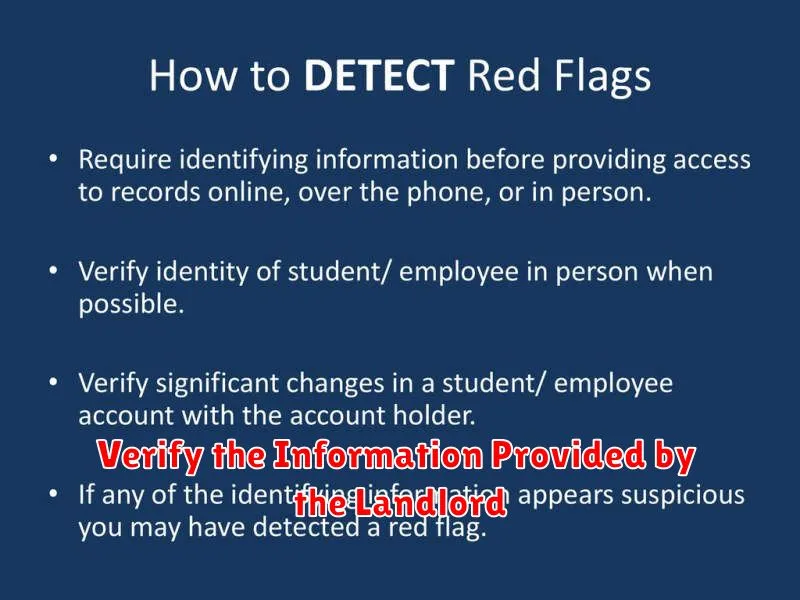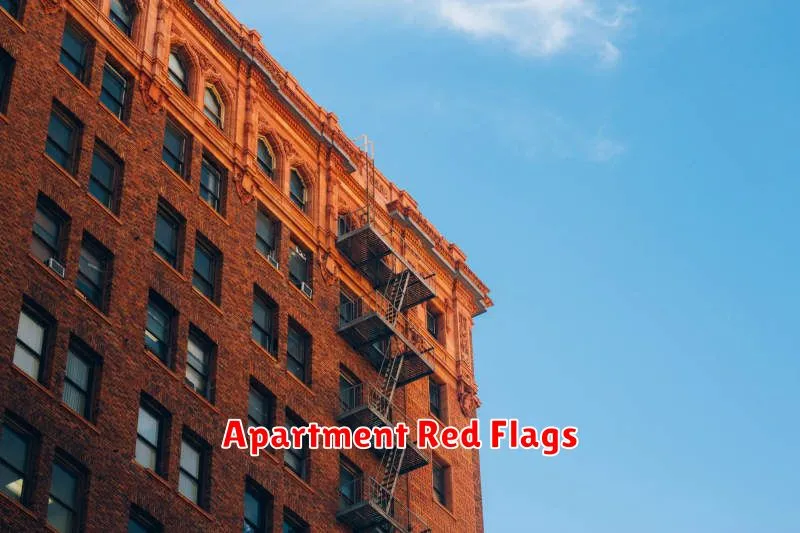Finding your dream apartment can be exciting, but it’s crucial to stay vigilant and watch out for red flags. These warning signs can signal potential problems with the landlord, property, or neighborhood, saving you from future headaches and financial burdens. From hidden fees to unresponsive landlords, this article will guide you through the key red flags to look for when apartment hunting, empowering you to make an informed and safe decision.
Signs of a Bad Landlord or Property Manager
Finding a new place to live can be exciting, but it’s also important to be cautious. Not all landlords and property managers are created equal. Some may prioritize their own profit over tenant well-being. Identifying these red flags early can prevent you from getting stuck in a bad rental situation.
Here are some signs of a bad landlord or property manager:
- Lack of communication: A landlord who is unresponsive to your calls, emails, or texts is a red flag. They may be difficult to reach when you need them, such as during an emergency.
- Unwillingness to make repairs: A landlord who refuses to fix essential repairs like plumbing issues, broken appliances, or safety hazards is putting your health and safety at risk. They may also use this as a reason to avoid renewing your lease.
- Unreasonable rent increases: A landlord who raises your rent significantly without justification or warning can be unfair. This can be especially challenging if the property is not well-maintained or if the neighborhood is declining in value.
- Disregard for privacy: A landlord who enters your unit without notice or reason, even if it’s for maintenance, is violating your privacy. They may also attempt to access your personal belongings without your consent.
- Ignoring tenant rights: Landlords are legally obligated to follow tenant laws. If they consistently violate your rights, such as failing to provide a safe and habitable environment, they are not trustworthy.
- Lack of professionalism: A landlord who is rude, disrespectful, or unprofessional is a sign that they may not be a good fit. They may not be willing to work with you in a fair and reasonable manner.
If you encounter any of these signs, it’s important to document the issues, gather evidence, and consider seeking legal advice. You may also want to consider finding a new apartment. Remember, a good landlord or property manager will prioritize your well-being and treat you with respect.
Inspecting the Exterior: What to Look For
The exterior of an apartment building can tell you a lot about its condition and the level of care it receives. Here are some key things to look for:
Maintenance: Are there any visible signs of neglect, like peeling paint, cracked sidewalks, or overgrown landscaping? This could indicate the landlord isn’t proactive about repairs and upkeep.
Safety: Check for well-lit parking areas and entryways. Make sure there are working security cameras or other safety features. Do the doors and windows appear secure?
Cleanliness: Is the building clean and free of litter? Does the exterior look well-maintained? This can be an indicator of the overall condition of the building.
Neighborhood: Pay attention to the surrounding area. Does it feel safe and welcoming? Are there any signs of crime or excessive noise?
General Impression: What is your overall impression of the building and the surrounding neighborhood? Trust your instincts, if something feels off, it might be worth considering other options.
Common Interior Red Flags: From Pests to Plumbing
Beyond the charm of a spacious living room or a modern kitchen, there are crucial interior red flags that can signal potential headaches for your future apartment living. These red flags go beyond aesthetic flaws; they can reveal underlying issues that might cost you time, money, and peace of mind. Let’s explore some common interior red flags to watch out for:
Pests: The presence of cockroaches, ants, rodents, or other pests is a major red flag. It not only indicates poor sanitation but also suggests a larger infestation problem that may be difficult and expensive to eradicate. Even if you spot just a few, inquire about the building’s pest control measures and history.
Plumbing Problems: Pay close attention to the bathroom and kitchen. Check for leaky faucets, low water pressure, slow draining sinks, or even visible water damage on the ceiling or walls. These are signs of underlying plumbing issues that can quickly escalate into costly repairs.
Mold and Mildew: Dampness, especially in bathrooms or basements, can lead to mold and mildew growth. Look for discoloration, a musty smell, or even peeling paint. Mold can trigger allergies and respiratory issues, making it essential to address early on.
Cracks and Structural Damage: Examine walls, ceilings, and floors for cracks, water stains, or uneven surfaces. These signs could indicate structural damage, foundation issues, or previous water leaks, all of which can be expensive to fix.
Electrical Issues: Flickering lights, faulty outlets, or a constant buzzing sound are common red flags. These could indicate overloaded circuits or a lack of proper electrical maintenance.
Safety Concerns: Evaluating Security Measures
Safety should be a top priority when apartment hunting. While location and amenities are important, it’s crucial to evaluate the security measures in place to ensure a safe living environment. Here are some key areas to focus on:
Building Security: Look for well-lit hallways, secure entryways, and working security cameras. A concierge or security personnel on duty can enhance safety. Ask about the building’s security protocols, such as tenant screening and visitor management.
Neighborhood Safety: Research crime statistics for the area and consider the overall feel of the neighborhood. Do you feel comfortable walking around at night? Are there any visible signs of crime or disorder?
Personal Safety Measures: Even in secure buildings, it’s wise to take precautions. Consider installing your own security system or using personal safety devices like alarms or pepper spray. Be mindful of your surroundings and report any suspicious activity to building management or the authorities.
By carefully evaluating security measures, you can minimize risks and choose an apartment that prioritizes your safety and peace of mind.
Neighborhood Nuances: Beyond the Apartment Itself
While the apartment itself is crucial, the surrounding neighborhood plays a significant role in your overall living experience. It’s essential to consider these factors beyond the walls of your potential home:
Noise Levels: Is the neighborhood bustling with traffic, sirens, or construction? Consider the proximity to busy streets, airports, train tracks, or any other potential sources of noise pollution. A quiet and peaceful environment contributes to a better quality of life.
Safety: Observe the neighborhood during different times of day and night. Check for well-lit streets, visible security measures, and the presence of police patrols. Look for signs of crime, such as graffiti or broken windows. If you feel uncomfortable walking around the neighborhood, it might be a red flag.
Amenities: Evaluate the availability of essential amenities like grocery stores, pharmacies, restaurants, and public transportation options. Do they meet your needs and preferences? Consider the distance and convenience of access to these amenities.
Community Vibe: Spend some time exploring the neighborhood and observing the people who live there. Does the community feel welcoming and safe? Look for community events, parks, or public spaces that foster social interaction and a sense of belonging.
Proximity to Work or School: Factor in your commute time and the convenience of getting to your workplace or school. Longer commutes can impact your overall well-being and stress levels. Consider the reliability and accessibility of public transportation options if you plan to rely on them.
Neighborhood History: Research the neighborhood’s history and recent developments. Any significant changes or controversies could be an indicator of future challenges or potential downsides.
By diligently exploring these neighborhood nuances, you can gain a more comprehensive understanding of your potential new home and make a more informed decision about whether it truly fits your lifestyle and needs.
Lease Agreement Red Flags: Hidden Clauses and Fees
You’ve found the perfect apartment, and you’re ready to sign the lease. Before you do, take a moment to carefully review the document. There may be hidden clauses or fees that could cost you a lot of money in the long run. Here are some red flags to look out for:
Early Termination Fees: Be wary of exorbitant early termination fees. A reasonable fee covers the landlord’s costs in finding a new tenant, but an excessive fee could trap you in a lease even if your circumstances change.
Pet Clauses: If you have a pet, ensure the pet clause is fair. Some landlords charge excessive pet deposits or monthly pet rent. Look for limits on the number or types of pets allowed.
Utility Fees: Scrutinize the language about utilities. Some landlords include “utility fees” in rent without specifying what they cover, allowing them to inflate rent.
“As Is” Clauses: Avoid leases that state the apartment is being rented “as is”. This clause absolves the landlord of responsibility for repairs, potentially leaving you responsible for costly fixes.
“Right of Entry” Clauses: The lease should clearly define the landlord’s right to access your apartment. Unreasonable restrictions on your privacy could be a problem.
Lease Renewal Clauses: Understand how the lease renewal process works. Some leases automatically renew for an additional period, which may come with rent increases. You may want to negotiate a shorter renewal period.
Hidden Fees: Watch out for fees that are not clearly outlined in the lease. This could include fees for late rent payments, parking, amenities, or even using the laundry facilities.
Review carefully: Before signing any lease, take the time to read it thoroughly. Ask questions if you don’t understand any clauses. Don’t hesitate to negotiate or walk away if you’re not comfortable with the terms.
Dealing with Pushy Landlords or Unclear Communication
A pushy landlord or unclear communication can be a major red flag during your apartment hunt. While enthusiasm might seem positive, a landlord who pressures you to sign a lease before fully understanding the terms or rushes you through a tour without answering questions could be a sign of trouble.
Clear communication is essential for a healthy landlord-tenant relationship. Be wary of landlords who are reluctant to provide information, avoid answering questions directly, or use vague language. Trust your gut if something feels off. Don’t feel pressured to commit to a lease before you’ve fully understood the terms and conditions.
If a landlord is pressuring you to make a decision, politely but firmly state that you need more time to review the lease and ask any outstanding questions. You have the right to make an informed decision.
Verify the Information Provided by the Landlord

Landlords are often eager to rent out their properties, and they may not always be entirely truthful about the details. It’s important to be skeptical and verify the information they provide. Don’t take their word for it; double-check everything.
Here are some key areas to investigate:
- Rental History: Ask for a copy of the previous tenant’s lease agreement. This can provide insight into any past issues or conflicts.
- Property Taxes: Check the local property tax records to see if the landlord is current on their payments. A delinquent property tax bill could be a sign of financial troubles.
- Building Codes: Ensure the property meets local building codes. You can contact your city or county government to find out the requirements.
- Utilities: Confirm with the utility companies that the property is in good standing and that utilities are connected.
- Insurance: Ask for proof of landlord insurance. This protects you in case of any unforeseen events.
Don’t hesitate to ask questions and be thorough in your research. A little effort now can save you from a lot of hassle and potential headaches down the road.
Document Everything: Photos and Written Records

When apartment hunting, it’s crucial to document everything you encounter, including photos and written records. This comprehensive documentation can be a lifesaver if any issues arise with the landlord or property later on.
Take detailed photos of any existing damage, including cracks in the walls, water stains, peeling paint, or malfunctioning appliances. These photos will serve as evidence of pre-existing conditions and help you avoid being held responsible for damages you didn’t cause.
Preserve copies of all communication, including emails, text messages, and letters. This includes any lease agreements, maintenance requests, and correspondence with the landlord or property management. These records will provide a paper trail in case of disputes.
Furthermore, if you discover a potential red flag, such as a landlord’s reluctance to address repairs or inconsistencies in the lease agreement, document these issues meticulously. This documentation can be invaluable if you decide to pursue legal action.
By diligently documenting everything, you can protect yourself from future headaches and ensure a smooth and fair rental experience. Remember, a well-organized record can be your strongest defense against unexpected challenges.
Trust Your Gut: When Something Feels Off

In the excitement of finding a new place to live, it’s easy to get caught up in the moment and overlook potential red flags. But your gut feeling is often a powerful indicator. If something just doesn’t feel right, even if you can’t pinpoint the exact reason, it’s important to trust your instincts.
Here are some scenarios where trusting your gut might be crucial:
- The landlord seems evasive or reluctant to answer your questions. This could be a sign that they’re trying to hide something about the apartment or the building.
- The apartment feels dirty or neglected. Even if the landlord promises to clean it up, this could be a sign of deeper problems.
- You get a bad vibe from the other tenants. This could indicate a problematic building environment.
- The lease agreement seems too good to be true. Be wary of overly low rent or excessively generous terms. There might be hidden costs or conditions.
If you have any doubts or concerns, don’t hesitate to ask questions, do your research, and trust your gut. It’s better to be safe than sorry when it comes to choosing a place to live.
Additional Tips for Avoiding Rental Scams
Beyond the red flags mentioned earlier, here are some additional tips to safeguard yourself against rental scams:
Be wary of deals that seem too good to be true. If the rent is significantly lower than other comparable units in the area, it could be a red flag. Scammers may use low prices to entice unsuspecting renters.
Never wire money to someone you’ve never met in person. Legitimate landlords typically accept rent payments through secure online platforms, cashier’s checks, or money orders delivered in person.
Always get everything in writing. This includes the lease agreement, any disclosures about the property, and payment terms. If something sounds too good to be true or you’re uncomfortable with a specific clause, have it clarified in writing.
Do your research on the landlord. Check online reviews, look for their contact information, and verify their license if required in your area. A legitimate landlord will have a verifiable presence and be willing to provide details about their business practices.
Trust your instincts. If something feels off about a potential rental or the landlord, it’s better to walk away. There are many legitimate rentals available, so don’t settle for anything that makes you uncomfortable.

